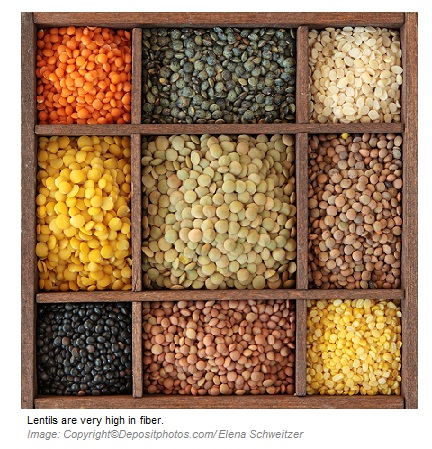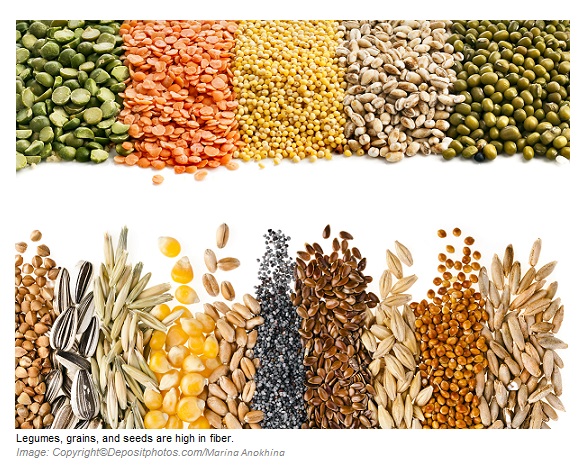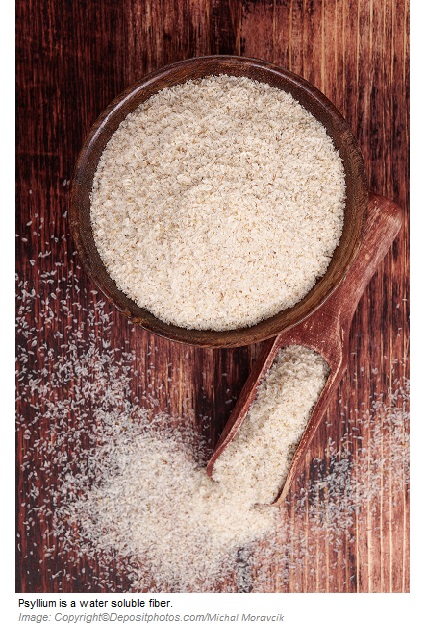Fiber is a non-starchy carbohydrate that the body is unable to digest. Being  exclusively a plant nutrient, fiber cannot be chemically broken down by human digestive enzymes, though a small amount is fermented by the bacteria in the intestine.
exclusively a plant nutrient, fiber cannot be chemically broken down by human digestive enzymes, though a small amount is fermented by the bacteria in the intestine.
There are two types of fibers: water – soluble and water – insoluble.
Benefits of Fiber:
1) Helps soften the stool and encourages normal bowel function.
2) Alleviates constipation.
3) Promote satiety.
4) Lowers bad cholesterol level.
5) Lowers blood sugar level.
6) May reduce the risk of developing diabetes type II.
7) Reduces the risk of colon, breast and prostate cancers.
8) Improves cardiovascular health.
9) Promotes insulin sensitivity.
10) Has a protective effect against diverticulosis.
11) Is useful in weight management.
How Much Fiber Do We Need?
It is recommended that adults to take 25 – 35 grams of fiber per day or 25 grams of fiber per 2000 calories per day, whichever is higher. Also it is suggested that the ratio of insoluble fiber to soluble fiber in daily diet should be 3 to 1.
Excessive intake of fiber may inhibit the absorption of the minerals iron, calcium, and phosphorus.
For the chemical components, food sources, and differences of the two fibers, see the tables below.

Dietary Fiber: Chemical Components |
a) Cellulose – Glucans b) Chitins – Chitosan (synthetic) c) Hemicellulose – Beta-glucans – Galactomannans – Glucomannans – Gums – Mucilage – Pectins 1) Arabinogalactans 2) Rhamnogalacturonans – Xylans – Xyloglucans d) Inulin e) Lignins f) Oligosaccharides – Fructans – Raffinose – Stachyose g) Waxes |

Dietary Fiber: Differences | |
Water – Soluble | Water – Insoluble |
1) Dissolves in water and forms a gel. 2) Slows the rate of the passage of foods through the small intestine, increasing absorption of nutrients. 3) Can be easily fermented into gases in the colon. 4) Lowers LDL cholesterol. 5) Less effect on blood sugar. | 1) Does not dissolve in water. 2) Accelerates the movement of foods via GI system by acting as bulking agents and laxatives. 3) Can be slightly fermented into gases in the colon. 4) Does not lower cholesterol. 5) More effect on blood sugar. |
Types of Dietary Fiber: | |
Water – Soluble | Water – Insoluble |
Barley Chia seeds Flaxseeds Fruits: – Apple (skin) – Avocado – Bananas (ripe) – Berries – Pears (skin) – Plums – Prunes – Quince (skin) Legumes Nuts, especially almonds Oats Psyllium Rye Vegetables: – Artichoke – Broccoli – Carrots – Onions – Sweet potato | Corn bran Flaxseeds Fruits: – Avocado – Bananas (unripe) – Grapes (skin) – Kiwi (skin) Legumes Vegetables: – Cauliflower – Celery – Green beans – Potatoes (skin) – Tomatoes (skin) – Zucchini Wheat Whole grains |

